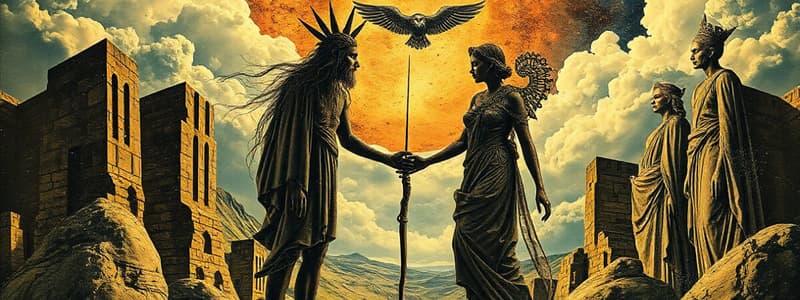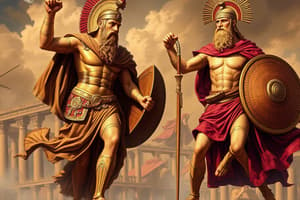Podcast
Questions and Answers
Which entity represents the primordial state of the universe in Greek mythology?
Which entity represents the primordial state of the universe in Greek mythology?
- Eros
- Uranus
- Chaos (correct)
- Gaia
Cronus castrated Uranus to free his siblings imprisoned within Gaia.
Cronus castrated Uranus to free his siblings imprisoned within Gaia.
True (A)
Name one of the beings created from Uranus's blood.
Name one of the beings created from Uranus's blood.
The Erinyes, The Giants, or The Meliae
Gaia is the personification of the ______.
Gaia is the personification of the ______.
Match the following entities with their descriptions:
Match the following entities with their descriptions:
What was the relationship between Rhea and Cronus?
What was the relationship between Rhea and Cronus?
Nyx and Erebus are embodiments of light in Greek mythology.
Nyx and Erebus are embodiments of light in Greek mythology.
What did Rhea give to Cronus to trick him into swallowing a stone?
What did Rhea give to Cronus to trick him into swallowing a stone?
What was the primary outcome of the Titanomachy?
What was the primary outcome of the Titanomachy?
Hera is known as the goddess of the sea.
Hera is known as the goddess of the sea.
What critical role did Rhea play in the survival of Zeus?
What critical role did Rhea play in the survival of Zeus?
Zeus's structured rule symbolizes the progression from disorder to __________.
Zeus's structured rule symbolizes the progression from disorder to __________.
Match the following Greek gods with their domains:
Match the following Greek gods with their domains:
Which theme is emphasized by the victory of the Olympians?
Which theme is emphasized by the victory of the Olympians?
Gaia played a passive role in the succession of power.
Gaia played a passive role in the succession of power.
What key characteristic distinguishes heroes in Greek mythology?
What key characteristic distinguishes heroes in Greek mythology?
What term describes the human weaknesses of heroes, such as pride and anger?
What term describes the human weaknesses of heroes, such as pride and anger?
Heracles is known for his intelligence and cleverness primarily.
Heracles is known for his intelligence and cleverness primarily.
What is the main significance of the Twelve Labors performed by Heracles?
What is the main significance of the Twelve Labors performed by Heracles?
Perseus used a mirrored shield to defeat the monster Medusa, which illustrates the importance of _____ in heroic myths.
Perseus used a mirrored shield to defeat the monster Medusa, which illustrates the importance of _____ in heroic myths.
What does the pursuit of glory (Kleos) signify for heroes?
What does the pursuit of glory (Kleos) signify for heroes?
Match the following heroes with their significant deeds:
Match the following heroes with their significant deeds:
Heroes often overcome monsters as a way to symbolize humanity's struggle against chaos.
Heroes often overcome monsters as a way to symbolize humanity's struggle against chaos.
What is the primary theme showcased by Theseus when he defeats the Minotaur?
What is the primary theme showcased by Theseus when he defeats the Minotaur?
Flashcards
Chaos
Chaos
A formless void that existed before the universe was formed in Greek mythology.
Gaia
Gaia
The personification of the earth in Greek mythology, believed to be the source of life.
Tartarus
Tartarus
The deep abyss beneath the earth in Greek mythology, associated with punishment and darkness.
Eros
Eros
Signup and view all the flashcards
Nyx
Nyx
Signup and view all the flashcards
Erebus
Erebus
Signup and view all the flashcards
Uranus
Uranus
Signup and view all the flashcards
Titans
Titans
Signup and view all the flashcards
Heroic Age
Heroic Age
Signup and view all the flashcards
Arete
Arete
Signup and view all the flashcards
Titanomachy
Titanomachy
Signup and view all the flashcards
Imprisonment of the Titans
Imprisonment of the Titans
Signup and view all the flashcards
Olympian Hierarchy
Olympian Hierarchy
Signup and view all the flashcards
Order from Chaos
Order from Chaos
Signup and view all the flashcards
Cosmic Succession
Cosmic Succession
Signup and view all the flashcards
Role of Women in Creation
Role of Women in Creation
Signup and view all the flashcards
Call to Adventure
Call to Adventure
Signup and view all the flashcards
Meeting the Mentor
Meeting the Mentor
Signup and view all the flashcards
Tests, Allies, and Enemies
Tests, Allies, and Enemies
Signup and view all the flashcards
Approach and/or Crossing the Threshold
Approach and/or Crossing the Threshold
Signup and view all the flashcards
The Ordeal
The Ordeal
Signup and view all the flashcards
Reward (Seizing the Sword )
Reward (Seizing the Sword )
Signup and view all the flashcards
The Road Back
The Road Back
Signup and view all the flashcards
Master of Two Worlds
Master of Two Worlds
Signup and view all the flashcards
Study Notes
Myths of Creation and the Structure of the Cosmos
- Greek mythology describes the cosmos's formation, emphasizing chaos and order.
- Chaos was the initial formless void, from which foundational entities emerged.
- Gaia (Earth) personified the earth and was the origin of life.
- Tartarus was a deep abyss beneath the earth, associated with punishment.
- Eros (Desire) represented a primal force for creation and procreation.
- Nyx (Night) and Erebus (Darkness) embodied darkness and shadow.
- Gaia gave birth to Uranus (Sky), uniting earth and sky through marriage.
- Their union produced the Titans, Cyclopes, and Hecatoncheires.
- The Titans were the first generation gods, embodying elemental and cosmic forces.
- Cyclopes were skilled craftsmen.
- Hecatoncheires were hundred-handed giants, symbolizing overwhelming power.
The Succession Myth: Struggles for Cosmic Power
- Uranus imprisoned his children (Titans) within Gaia, causing her pain.
- Gaia encouraged Cronus to castrate Uranus, establishing him as the new ruler.
- Uranus's blood created beings including the Furies (Erinyes), Giants, and nymphs (Meliae).
- Cronus, fearing a prophecy, swallowed his children.
- Rhea saved Zeus by giving Cronus a stone instead.
- Zeus grew strong and liberated his siblings, leading the Olympians in war against the Titans (Titanomachy).
- The Olympians defeated the Titans, imprisoning them in Tartarus and establishing Zeus's rule.
Cosmic Order and the Olympian Rule
- Zeus declared himself king of the gods, establishing a structured divine hierarchy.
- Poseidon ruled the sea.
- Hades ruled the underworld.
- Hera was queen of the gods and goddess of marriage.
- Demeter was goddess of agriculture and fertility.
- Hestia was goddess of the hearth and domesticity.
Symbolism and Interpretation
- The myth of cosmic succession reflects generational struggles and the cyclical nature of power.
- Gaia's actions against Uranus initiated the succession of power.
- Rhea's actions ensured Zeus's survival, bringing order to the universe.
- The myths symbolize the progression from disorder to stability.
- Themes of balance were reinforced through the division of realms among Zeus, Poseidon, and Hades.
The Heroic Age: Heroes as Cultural Icons
- Greek mythology's Heroic Age bridges the divine and mortal realms, featuring larger-than-life figures embodying bravery, skill, and human imperfection.
- Key characteristics of heroes include excellence (arete), flaws (hamartia), and the pursuit of glory (kleos).
- Heroes face significant challenges including overcoming monsters, enemies, or impossible tasks.
- These conflicts often symbolize humanity's struggle against chaos and adversity.
- Heroes are mortal and their lives are often marked by tragedy, reflecting the fleeting nature of life.
- Heroes often rely on divine assistance or face opposition from the gods, showcasing the tension between human effort and fate.
Prominent Figures and Narratives
- Heracles represents the archetypal hero, known for his Twelve Labors testing strength and ingenuity.
- Tasks included slaying the Nemean Lion and capturing the Erymanthian Boar.
- Perseus, celebrated for slaying Medusa (a Gorgon whose gaze turned people to stone), received divine aid from Athena and Hermes.
- Theseus embodies courage, intelligence, and justice, defeating the Minotaur in the Labyrinth.
The Heroic Journey: Structure and Symbolism
- Stages of the hero's journey include: Call to Adventure, Trials and Challenges, and Return and Legacy.
- Heroes reflect societal values, embodying moral exemplars, such as loyalty, perseverance, and respect for the gods.
- Moral lessons include hubris and humility (excess pride) and human limitations (mortality).
Studying That Suits You
Use AI to generate personalized quizzes and flashcards to suit your learning preferences.




